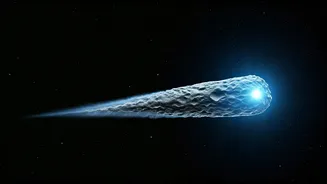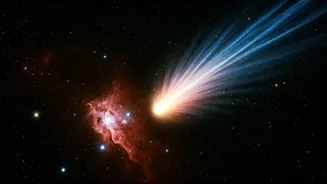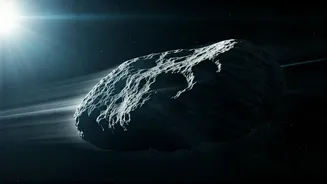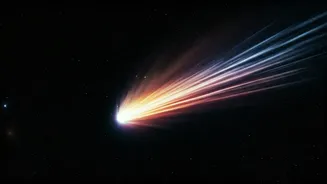A Cosmic Arrival
The discovery of an interstellar comet, also known as 3I/ATLAS, marked a significant event in the astronomical community, as it offered a unique opportunity
to study an object that originated from outside our solar system. The comet's journey, originating from another star system, presented scientists with an unparalleled chance to examine its composition and glean insights into the formation and evolution of other planetary systems. Its arrival sparked considerable excitement, prompting astronomers worldwide to mobilize their observational resources in order to study the comet as it traversed the inner solar system. The unusual activity, including jets, tail formation, and potential water leakage, made this a particularly captivating object, drawing attention from both professional astronomers and amateur skywatchers eager to witness this rare cosmic event.
Spotting the Intruder
The initial sighting of the interstellar comet, a crucial moment in its history, was enabled by modern astronomical survey telescopes designed to scan the skies for transient objects. These telescopes, with their advanced technology, are instrumental in detecting faint comets. The comet's discovery triggered a wave of observations as scientists and astronomers around the globe raced to gather data. They employed a variety of instruments, including ground-based telescopes and space-based observatories, to track the comet's trajectory, analyze its composition, and monitor its activity. Detailed observations were made by studying the light spectrum, allowing scientists to identify the elements present in the comet's nucleus and its surrounding coma and tail. These various methods collectively provided a comprehensive view of the comet's properties and behavior.
Origins and Journey
Comet 3I/ATLAS's origin outside our solar system places it in a different star system, thus creating much speculation as to where it originally originated. The comet's path and speed gave crucial information about its journey. Its trajectory, marked by a hyperbolic orbit, confirmed its interstellar origin, distinguishing it from comets that orbit the sun. The comet's extreme speed indicated that it wasn't gravitationally bound to our sun, reinforcing the idea that it came from far beyond our solar system. Studying its path gave scientists insights into the conditions of interstellar space and the mechanisms by which comets are ejected from their home systems. Its astonishing voyage showed scientists a chance to learn about the formation of other stars and how objects like comets roam through the universe.
Clues and Composition
The size, age, and composition of the comet provided critical clues to its nature and origin. The comet's size, initially estimated based on its brightness and the amount of gas and dust it released, provided data about its structure. Examining the comet's nucleus, the solid core, and its coma, the surrounding cloud of gas and dust, enabled the researchers to gain information. The composition of the comet revealed valuable information about the building blocks of planets and the early solar systems. The data acquired from the comet's composition, including the presence of water ice, organic molecules, and other compounds, supplied essential evidence that could be compared with other comets and celestial objects, providing insights into the distribution of elements in the cosmos.
Why It Matters
The importance of studying this interstellar comet lies in the wealth of information it carries about the universe and its origins. The comet's composition and structure act as a time capsule, preserving the building blocks of planetary systems that existed long ago. By studying the comet, scientists can gain important information about the formation and evolution of other star systems, including the distribution of materials like water and organic molecules. The comet offers a rare chance to understand the processes by which comets are ejected from their home systems, as well as the conditions within interstellar space. Studying the comet helps broaden our knowledge of the cosmos and our place within it. The ongoing observations and analysis of the comet will keep providing useful information about our place in the cosmos.
Observing the Visitor
Astronomers utilized various methods to observe and study the comet during its transit through our solar system. The timing and methods to observe the comet were determined by its trajectory and brightness. When the comet was closest to Earth, it was visible with the help of powerful telescopes and it was also observed by amateur astronomers. Scientists carefully tracked the comet’s changing behavior, including the development of a tail and gas, to collect valuable data. By examining the light reflected and emitted by the comet, astronomers acquired information about its composition and the processes that were ongoing. This detailed observation of the comet offered valuable knowledge about the comet itself, along with a better understanding of the formation of the early universe.
Speculation and Questions
The unusual activity exhibited by the comet and its interstellar nature sparked some discussions and speculation. Questions regarding its origin and the potential for life-bearing materials were raised within the scientific community and the public. Some speculated that the comet could potentially carry water or organic molecules, which are essential ingredients for life. The discussion around the comet's nature and composition opened further discussions regarding its journey and formation processes in other star systems. Scientists also pondered the frequency of such interstellar objects visiting our solar system, raising questions about the universe's dynamic and the potential for future discoveries. These discussions and questions drove further research and investigation, stimulating curiosity and innovation in astronomy.











